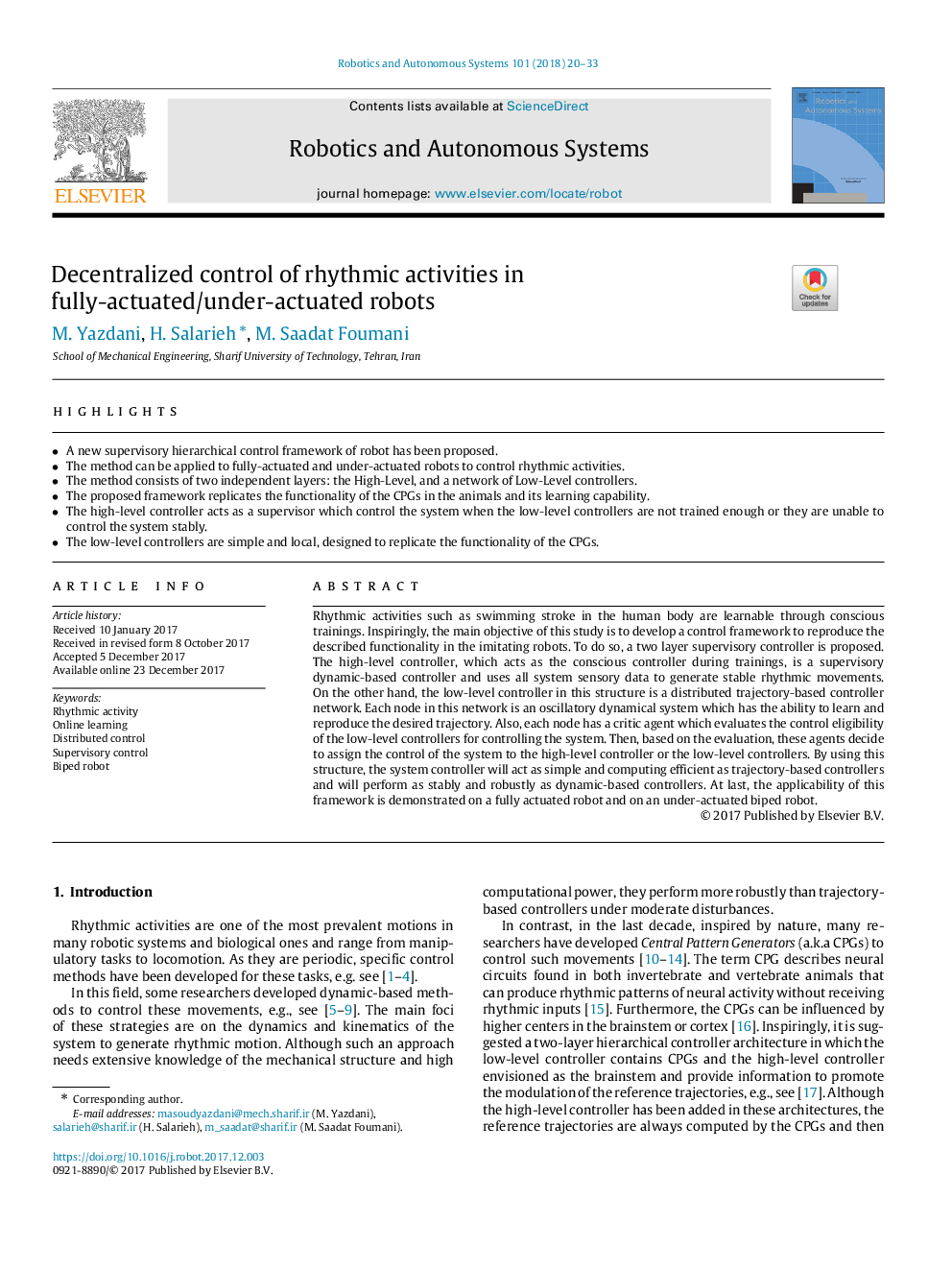| کد مقاله | کد نشریه | سال انتشار | مقاله انگلیسی | نسخه تمام متن |
|---|---|---|---|---|
| 6867253 | 1439841 | 2018 | 14 صفحه PDF | دانلود رایگان |
عنوان انگلیسی مقاله ISI
Decentralized control of rhythmic activities in fully-actuated/under-actuated robots
ترجمه فارسی عنوان
کنترل بی نظیری از فعالیت های ریتمیک در روبات های کاملا فعال / غیر فعال
دانلود مقاله + سفارش ترجمه
دانلود مقاله ISI انگلیسی
رایگان برای ایرانیان
کلمات کلیدی
ترجمه چکیده
فعالیت های ریتمیک مانند سکته مغزی شنا در بدن انسان از طریق آموزش های آگاهانه قابل یادگیری است. به طور چشمگیری، هدف اصلی این مطالعه، ایجاد یک چارچوب کنترل برای بازتولید عملکرد توصیف شده در روبات های تقلیدی است. برای انجام این کار، یک کنترل کننده کنترل دو لایه پیشنهاد می شود. کنترل کننده سطح بالا، که در طول تمرینات کنترل کننده آگاهانه عمل می کند، یک کنترل کننده مبتنی بر پویا نظارت است و از تمام داده های حسی سیستم برای ایجاد حرکات ریتم پایدار استفاده می کند. از سوی دیگر، کنترل کننده سطح پایین در این ساختار یک شبکه کنترل کننده مبتنی بر مسیریابی توزیع شده است. هر گره در این شبکه یک سیستم دینامیکی نوسانی است که توانایی یادگیری و تولید مسیر مورد نظر را دارد. همچنین، هر گره دارای یک عامل منتقد است که مقیاس پذیری کنترل از کنترل های سطح پایین را برای کنترل سیستم ارزیابی می کند. سپس، بر اساس ارزیابی، این عوامل تصمیم می گیرند کنترل سیستم را به کنترل کننده سطح بالا یا کنترل کننده های سطح پایین اختصاص دهند. با استفاده از این ساختار، کنترل کننده سیستم به عنوان ساده و محاسباتی به عنوان کنترل کننده های مبتنی بر مسیر عمل می کند و به صورت پایدار و قوی به عنوان کنترل کننده های مبتنی بر پویا عمل می کند. در نهایت، کاربرد این چارچوب بر روی یک ربات کاملا فعال و در یک ربات دوجداره با فشار کمتر نشان داده شده است.
موضوعات مرتبط
مهندسی و علوم پایه
مهندسی کامپیوتر
هوش مصنوعی
چکیده انگلیسی
Rhythmic activities such as swimming stroke in the human body are learnable through conscious trainings. Inspiringly, the main objective of this study is to develop a control framework to reproduce the described functionality in the imitating robots. To do so, a two layer supervisory controller is proposed. The high-level controller, which acts as the conscious controller during trainings, is a supervisory dynamic-based controller and uses all system sensory data to generate stable rhythmic movements. On the other hand, the low-level controller in this structure is a distributed trajectory-based controller network. Each node in this network is an oscillatory dynamical system which has the ability to learn and reproduce the desired trajectory. Also, each node has a critic agent which evaluates the control eligibility of the low-level controllers for controlling the system. Then, based on the evaluation, these agents decide to assign the control of the system to the high-level controller or the low-level controllers. By using this structure, the system controller will act as simple and computing efficient as trajectory-based controllers and will perform as stably and robustly as dynamic-based controllers. At last, the applicability of this framework is demonstrated on a fully actuated robot and on an under-actuated biped robot.
ناشر
Database: Elsevier - ScienceDirect (ساینس دایرکت)
Journal: Robotics and Autonomous Systems - Volume 101, March 2018, Pages 20-33
Journal: Robotics and Autonomous Systems - Volume 101, March 2018, Pages 20-33
نویسندگان
M. Yazdani, H. Salarieh, M. Saadat Foumani,
